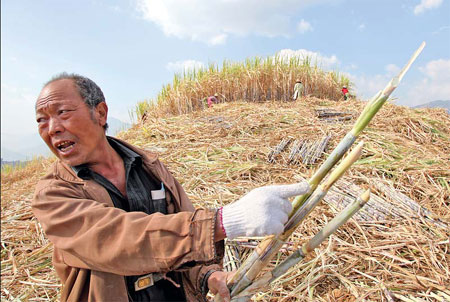Very little sweet news for sugar producers
Updated: 2012-02-21 11:00
By Li Lianxing, Li Yingqing and Guo Anfei (China Daily)
|
|||||||||||
|
 Li Xiuzhong, a farmer, said this kind of "incomplete" sugarcane makes up much of this year's harvest, in Ma'an Mountain of Yunxian county, Lincang, Yunnan province. [Photo/China Daily] |
LINCANG, Yunnan - "I can't expect any profit this year and I don't know what to do next year," said Li Xiuzhong, a 65-year-old sugarcane farmer in Lincang, Southwest China's Yunnan province.
"We have 180 hectares of sugarcane last year and actually the beginning of the growing season was good due to sufficient rainfall," he said. "But after June, things got worse so quickly and now there is no harvest in 30 hectares."
His expectations have also dropped from five tons of crops for each hectare to three tons.
"These are already the best drought-resistant seeds and I have ploughed another 40 hectares for next year, hoping to earn more money," he said. "But now, I have lost confidence in growing them under current weather conditions."
He said he had grown sugarcane for more than 20 years and this year is the worst in terms of weather.
He is living on income from previous years.
Lincang used to be covered with thick forests and has rich water resources, but since the 2010 drought, its water conservation facilities have been under threat and agricultural production has been challenged.
Lincang's sugar and tea industries are two pillars of its economy. Sixty percent of sugarcane crops were affected by the weather in 2010 and there was a conspicuous reduction of total production.
Ganhua Company is a major sugar factory in Yunxian county, and is experiencing a hard time with this year's harvest.
According to Wei Xuehua, general director of the company, the scarcity of water has handed the company, as well as sugarcane farmers and delivery drivers, a total loss of 19 million yuan ($3 million) so far.
In addition, rats have also severely affected the production of sugarcane in the region as water can only be found in the plants.
"We are cooperating with the government to build more channels now and it helps irrigation of those crops on the flat ground, but we still have to pin the future of those on the hills on God," Wei said.
As sugarcane normally would be reaped four times in four years, the planting cycle should be ensured every year. But the shattering of farmers' confidence this year has threatened the next year's harvest due to a decrease in planting.
Zhang Yuebin, director of the Sugarcane Research Institute of Yunnan Academy of Agricultural Sciences, said the reduction of sugarcane in Yunnan due to the drought would contribute to a price increase of national sugar.
"The price of sugar might be pushed up from 6,000 yuan per ton to 7,000 this year," he said, adding that this would be a reasonable price for farmers, companies and consumers.
But Zhang also said the influence of the reduction of Yunnan sugarcane would be limited as the Guangxi Zhuang autonomous region has 60 percent of the total sugarcane growing of China.
"Yunnan only contributes 20 percent to the national market and had a total production of 1.76 million tons of sugar last year and will see a minor increase this year to 2 million," he said. "But without the impact of water scarcity, we would have 2.3 million."
He added that national sugar prices in recent years have been enormously affected by natural disasters. Guangxi was stricken by freezing conditions a few years ago and Yunnan has experienced a persistent three-year drought.
Related Stories
Sugar auction to balance demand 2004-07-08 10:08
Purchase plan to steady sugar prices 2007-06-22 10:52
State reserve to stabilize sugar price 2006-06-14 17:02
Sugar futures fall amid auction 2006-04-26 09:05
- Consumers seek accident, health insurance
- MOC tops central government transparency list
- Very little sweet news for sugar producers
- Sing, dance and buy for New Year
- Avon appoints new head of China business
- Banks have record year amid economic troubles
- Bank of China moves closer to LME membership
- CSRC tightens rules on acquisitions









